A
Auto Express
Guest
The Renault Trafic is one of the best medium-sized vans for sale in the UK. The current Trafic first went on sale in 2014, but the introduction of new emissions-compliant diesels to the line-up in 2019 saw Renault also update the van's looks and technology.
Overall, the van's dimensions are unchanged, and the same Business, Business+ and Sport trims are for sale, while Black Edition adds a different look to the van. Up front the most recent update added a squarer shape for the lights and grille, while Renault's C-shaped LED daytime running light signature makes an appearance. Go for a top-spec Trafic, and LED headlights are also added, while chrome trim is offered for even more upmarket appeal. That's as far as the exterior updates go, but they could be enough to help draw in more buyers.
Where the Trafic will really win over buyers is inside, where Renault has made some more significant changes. Chief among them is the introduction of Renault's latest infotainment systems from the car range. There's R-Link and Media Nav systems on offer, so Android Auto and Apple CarPlay are now compatible (CarPlay is only offered on Media Nav, though), while an all-grey finish for the plastic trim and additional silver trim on the dashboard give the interior a bit of a lift.
In the back, the load area is unchanged, with the panel van coming in two body lengths and two roof heights, so cargo volume ranges from 3.2 cubic metres (for the Crew Van) to 8.6 cubic metres. A thru-load facility means items as long as 4.15 metres can be carried, thanks to a hatch in the bulkhead under the standard twin passenger seat. Also new is LED load bay lighting, which bathes the area in brilliant white light. If you need more seats, then the Trafic Crew Van is available, while the Trafic Passenger and Space Class versions are dedicated people movers. Renault also offers a number of conversion options, including a camper van.
Trafic trim levels are Business, Business+ and Sport with all models getting a DAB radio with Bluetooth, ESC stability control, a full steel bulkhead, remote central locking and a sliding side door on the left. Business+ adds air-conditioning, rear parking sensors, the clever load-through bulkhead and Renault's Mobile Office (dashboard device cradles plus a middle passenger seat that folds down to reveal a clipboard and lab-top storage). Sport models get all that plus alloy wheels, touchscreen sat-nav and cruise control as well as other styling add-ons, while Black Edition adds gloss black plastic trim and black alloy wheels.

2019 Renault Trafic interior
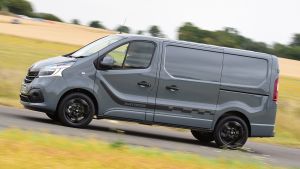
image

image
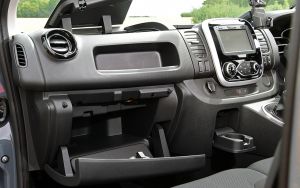
image
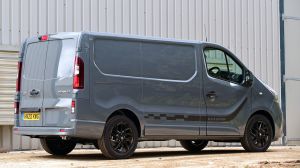
image
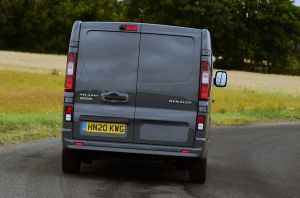
image
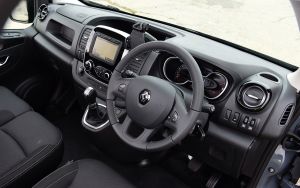
image
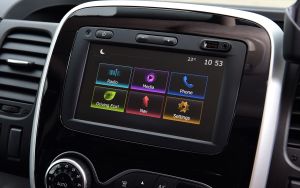
image
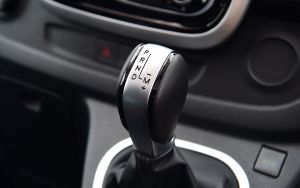
image
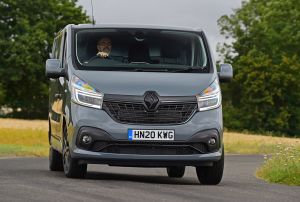
image

image
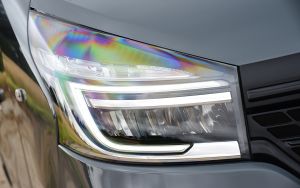
image

image
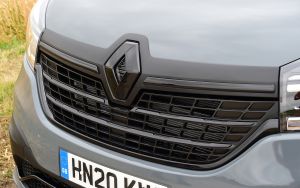
image
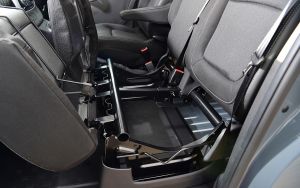
image
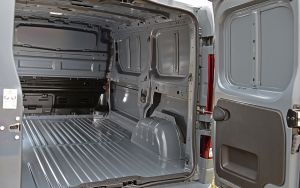
image
Under the bonnet is the other area where updates have been made. The 1.6 dCi twin-turbodiesel has been replaced by a larger 2.0 dCi with a single variable-geometry turbocharger and stop-start fitted across the range. The larger capacity is designed to help the Trafic meet the latest emissions legislation, as well as improve responses. It comes in 120, 145 and 170 guises, with 118, 143 and 168bhp respectively, All vans are front-wheel drive with a six-speed manual gearbox, while a six-speed dual-clutch auto is offered with the dCi 145 and 170 engines.
As before, the Trafic has a number of strong rivals. The main one is the Ford Transit Custom, but there's also the Mercedes Vito and Volkswagen T6 Transporter. All of these vans have plenty of space and car-like touches in the cabin and are well worth a look.
Elsewhere, the Vauxhall Vivaro - a van once closely linked to the Trafic - now shares its running gear with the Peugeot Expert, Citroen Dispatch and Toyota Proace. All four of these are even more car-like to drive than their rivals, but they do sacrifice ultimate carrying capacity when compared to the Trafic. Finally, there's the Nissan NV300 and Fiat Talento, both of which are built in the same factory as the Renault in France, and with similar kit levels and cargo space inside.
Renault claims that there is an improvement of around 2 per cent in terms of fuel efficiency when the new 2.0 dCi diesel is directly compared with the older 1.6 dCi engines. For that engine, the headline combined economy figure was 47.9mpg achieved by the dCi 120 model with CO2 emissions of 155g/km. However, this new engine is designed to meet the tougher WLTP test procedure, so the official fuel economy figures are lower, but you're more likely to achieve them in real-world driving.
The best combined WLTP fuel consumption figure for the Trafic is 39.8mpg, which is the same for all three power outputs with the manual gearbox. Add the dual-clutch auto, and the best combined WLTP figure is 38.7mpg for both power outputs on offer.
The new 2.0 dCi engine comes with stop-start as standard to help improve fuel economy, while Renault's 'ECO' mode button has also been retained. Press this and it dulls the throttle response on the van to keep the engine revs in check. Gear shift indicators and a light on the dashboard that changes from green to yellow to red depending on how heavy you are using the throttle also helps you to be more efficient. In addition, there are tips to improve your driving style within the infotainment system, which can help you to produce a real-world economy benefit if the driver takes any notice.

2019 Renault Trafic interior

image

image

image

image

image

image

image

image

image

image

image

image

image

image

image
While Renault once offered a 4-year/100,000-mile warranty, the current Trafic has a standard 3-year policy, although it still has a 100,000-mile distance limit.
Operators may well be casting an anxious eye towards the Trafic's front light clusters (especially the LED ones) and the big painted bumpers on higher-spec vans, but Renault assures us that repair costs on the Trafic have been kept firmly in check. The bumpers on the entry-level versions are unpainted as standard.
The Renault Trafic is one of the most spacious mid-sized vans on the market, and this remains true with the arrival of the updated model in 2019.
An overall length of 4,999mm for the standard Trafic means it's one of the longer vans on the market, and it means the standard panel van has 5.2 cubic metres of cargo volume in the back. Crucially, this enables the smallest Trafic to carry three Europallets or 11 standard sheets of plasterboard.
Moreover, Renault includes a special 'load through bulkhead' on Business+ models and above. This is basically 2 flaps, one at floor level in the bulkhead behind the passenger seat and a second under the passenger seat itself. Open the first and planks or piping of up to 2.94m in length can be accommodated. Open the second and you've got 3.75m to play with. Again, that's in the short-wheelbase model. In the long wheelbase Trafic with the load through bulkhead, the maximum load length is a class-leading 4.15m.

2019 Renault Trafic interior

image

image

image

image

image

image

image

image

image

image

image

image

image

image

image
Renault also fits a clever catch for the asymmetrically-split rear doors. This allows the left hand door that carries the Trafic's rear numberplate to be locked in place so very long items can be poked out of the right hand door and carried with rear lights and numberplate visible. An internal ceiling rack is also available as an option, along with Renault's Ready4Work range of fully warrantied internal racking and storage solutions.
As well as the panel vans in two wheelbases and two roof heights, Renault offers a six-seater crew van, a nine-seater minibus and a platform cab ready to take a host of conversions. There's also the luxury seven-seat Trafic Space Class MPV, which takes on the Volkswagen Caravelle and Mercedes V-Class.
As standard, the Renault Trafic has a solid safety specification. The full steel bulkhead forms a robust barrier between occupants and cargo, then there's a driver's airbag, ABS with EBD and ESC stability control with hill start assist and Grip Xtend to help out on slippery surfaces. Extra airbags are cost options. The 2019 update added options such as front and rear parking sensors, a rear camera and automatic emergency braking.
The Business+ model adds the 'Wide View Mirror', which is a giant vanity mirror on the passenger sun visor. It eliminates the Trafic's blind spot by increasing the driver's field of vision down the offside flank of the van. The only problem is that any passenger is left staring at their reflection for the duration of the trip, which is fine for narcissists. On the security front, all models get deadlocks, an immobiliser and an alarm, while Renault offers a number of deadlocks and security add-ons as part of the Trafic's range of accessories.
Should something go wrong, Renault's PRO+ network of van centres offers a van-for-van courtesy vehicle while yours is off the road, a diagnostic report within the hour and a maximum 48-hour lead time for servicing and repairs.

2019 Renault Trafic interior

image

image

image

image

image

image

image

image

image

image

image

image

image

image

image
The Renault Trafic's new 2.0-litre engine is a smooth performer. There's hardly any diesel rattle, while the most powerful 168bhp version also has 380Nm of torque at low revs, so it pulls sweetly from 1,600rpm. Even the lowest-powered model packs a surprising amount of punch, courtesy of its 320Nm torque figure.
On the road, the Trafic is largely the same as before, with a commanding view of the road, a comfortable driving position and good rearward visibility. The 2.0 dCi makes life easy, too, while the six-speed gearbox has a decent shift. The suspension delivers a reasonable balance between comfort and load carrying (we tried a Trafic with a 440kg payload), and the Trafic is pretty smooth on longer runs.
That high driving position helps in town, while wide-angle mirrors - including the additional wide-view mirror in the passenger-side sun visor - help you to manoeuvre. A rear camera, front and rear parking sensors, lane departure and city braking are all available, too.
There's also a new six-speed auto gearbox offered in the Trafic. This is Renault's EDC auto, and it really takes the strain out of driving in town. It shifts smoothly, although it's a bit slow to react when you accelerate, and it does seem keen to kick down whenever you use the throttle, which can send the revs soaring. There's a manual mode (but no paddleshifters) which is effective at holding gears when you're negotiating a steep downhill slope.
Renault has brought a number of passenger car touches to the interior of the Trafic, but the van's cabin is still designed primarily as a working environment. The dashboard is now moulded in a single grey colour that's designed to give it a more upmarket feel than the older two-tone design, and it's made from tough, solid-feeling plastics, too. Silver trim on higher-spec vans gives it a lift, too.
There's up to 90 litres of storage space inside the cab, depending on which of the 14 possible storage spaces are present. The highlight from a user-friendliness point of view is Renault's Mobile Office which is found on Business+ models and above. It's a middle front passenger seat with a fold-down back that reveals a table with detachable clipboard and a laptop storage space. It doesn't seem to be quite on a par with the rest of the cabin in terms of robustness, but it will definitely be a useful addition for those with paperwork to do on the move.

2019 Renault Trafic interior

image

image

image

image

image

image

image

image

image

image

image

image

image

image

image
Also on Business+ models is a built-in smartphone cradle that locates your phone within easy reach and sight, although it's not the most sophisticated addition these days. A larger cradle for tablet devices can also be specified.
The Trafic range now features Renault's R-Link Evolution and Media Nav Evolution infotainment systems from the Renault car range. These systems allow you to hook up a smartphone and use either Android Auto or Apple CarPlay, although the latter is only compatible with the pricier Media Nav system. Whichever you choose, Bluetooth is standard on all vans, so connectivity shouldn't be an issue. USB and 12-volt charging sockets also feature, and you can add 12-volt charging to the cargo area, too.
Finally, another great piece of kit that we'd certainly consider from the options list is Renault's hands-free key card. With this drivers can open the Trafic's doors, start the engine and drive away without ever having to take the key out of their pocket.
Van dimensions
Width including door mirrors: 2,283mm
Load area dimensions
Continue reading...
Overall, the van's dimensions are unchanged, and the same Business, Business+ and Sport trims are for sale, while Black Edition adds a different look to the van. Up front the most recent update added a squarer shape for the lights and grille, while Renault's C-shaped LED daytime running light signature makes an appearance. Go for a top-spec Trafic, and LED headlights are also added, while chrome trim is offered for even more upmarket appeal. That's as far as the exterior updates go, but they could be enough to help draw in more buyers.
- SEE MORE Best medium panel vans to buy 2020
Where the Trafic will really win over buyers is inside, where Renault has made some more significant changes. Chief among them is the introduction of Renault's latest infotainment systems from the car range. There's R-Link and Media Nav systems on offer, so Android Auto and Apple CarPlay are now compatible (CarPlay is only offered on Media Nav, though), while an all-grey finish for the plastic trim and additional silver trim on the dashboard give the interior a bit of a lift.
In the back, the load area is unchanged, with the panel van coming in two body lengths and two roof heights, so cargo volume ranges from 3.2 cubic metres (for the Crew Van) to 8.6 cubic metres. A thru-load facility means items as long as 4.15 metres can be carried, thanks to a hatch in the bulkhead under the standard twin passenger seat. Also new is LED load bay lighting, which bathes the area in brilliant white light. If you need more seats, then the Trafic Crew Van is available, while the Trafic Passenger and Space Class versions are dedicated people movers. Renault also offers a number of conversion options, including a camper van.
Trafic trim levels are Business, Business+ and Sport with all models getting a DAB radio with Bluetooth, ESC stability control, a full steel bulkhead, remote central locking and a sliding side door on the left. Business+ adds air-conditioning, rear parking sensors, the clever load-through bulkhead and Renault's Mobile Office (dashboard device cradles plus a middle passenger seat that folds down to reveal a clipboard and lab-top storage). Sport models get all that plus alloy wheels, touchscreen sat-nav and cruise control as well as other styling add-ons, while Black Edition adds gloss black plastic trim and black alloy wheels.
2019 Renault Trafic interior

image
image

image

image

image

image

image

image

image

image

image

image

image

image

image
Under the bonnet is the other area where updates have been made. The 1.6 dCi twin-turbodiesel has been replaced by a larger 2.0 dCi with a single variable-geometry turbocharger and stop-start fitted across the range. The larger capacity is designed to help the Trafic meet the latest emissions legislation, as well as improve responses. It comes in 120, 145 and 170 guises, with 118, 143 and 168bhp respectively, All vans are front-wheel drive with a six-speed manual gearbox, while a six-speed dual-clutch auto is offered with the dCi 145 and 170 engines.
As before, the Trafic has a number of strong rivals. The main one is the Ford Transit Custom, but there's also the Mercedes Vito and Volkswagen T6 Transporter. All of these vans have plenty of space and car-like touches in the cabin and are well worth a look.
Elsewhere, the Vauxhall Vivaro - a van once closely linked to the Trafic - now shares its running gear with the Peugeot Expert, Citroen Dispatch and Toyota Proace. All four of these are even more car-like to drive than their rivals, but they do sacrifice ultimate carrying capacity when compared to the Trafic. Finally, there's the Nissan NV300 and Fiat Talento, both of which are built in the same factory as the Renault in France, and with similar kit levels and cargo space inside.
Renault claims that there is an improvement of around 2 per cent in terms of fuel efficiency when the new 2.0 dCi diesel is directly compared with the older 1.6 dCi engines. For that engine, the headline combined economy figure was 47.9mpg achieved by the dCi 120 model with CO2 emissions of 155g/km. However, this new engine is designed to meet the tougher WLTP test procedure, so the official fuel economy figures are lower, but you're more likely to achieve them in real-world driving.
The best combined WLTP fuel consumption figure for the Trafic is 39.8mpg, which is the same for all three power outputs with the manual gearbox. Add the dual-clutch auto, and the best combined WLTP figure is 38.7mpg for both power outputs on offer.
The new 2.0 dCi engine comes with stop-start as standard to help improve fuel economy, while Renault's 'ECO' mode button has also been retained. Press this and it dulls the throttle response on the van to keep the engine revs in check. Gear shift indicators and a light on the dashboard that changes from green to yellow to red depending on how heavy you are using the throttle also helps you to be more efficient. In addition, there are tips to improve your driving style within the infotainment system, which can help you to produce a real-world economy benefit if the driver takes any notice.
2019 Renault Trafic interior

image
image

image

image

image

image

image

image

image

image

image

image

image

image

image
While Renault once offered a 4-year/100,000-mile warranty, the current Trafic has a standard 3-year policy, although it still has a 100,000-mile distance limit.
Operators may well be casting an anxious eye towards the Trafic's front light clusters (especially the LED ones) and the big painted bumpers on higher-spec vans, but Renault assures us that repair costs on the Trafic have been kept firmly in check. The bumpers on the entry-level versions are unpainted as standard.
The Renault Trafic is one of the most spacious mid-sized vans on the market, and this remains true with the arrival of the updated model in 2019.
An overall length of 4,999mm for the standard Trafic means it's one of the longer vans on the market, and it means the standard panel van has 5.2 cubic metres of cargo volume in the back. Crucially, this enables the smallest Trafic to carry three Europallets or 11 standard sheets of plasterboard.
Moreover, Renault includes a special 'load through bulkhead' on Business+ models and above. This is basically 2 flaps, one at floor level in the bulkhead behind the passenger seat and a second under the passenger seat itself. Open the first and planks or piping of up to 2.94m in length can be accommodated. Open the second and you've got 3.75m to play with. Again, that's in the short-wheelbase model. In the long wheelbase Trafic with the load through bulkhead, the maximum load length is a class-leading 4.15m.
2019 Renault Trafic interior

image
image

image

image

image

image

image

image

image

image

image

image

image

image

image
Renault also fits a clever catch for the asymmetrically-split rear doors. This allows the left hand door that carries the Trafic's rear numberplate to be locked in place so very long items can be poked out of the right hand door and carried with rear lights and numberplate visible. An internal ceiling rack is also available as an option, along with Renault's Ready4Work range of fully warrantied internal racking and storage solutions.
As well as the panel vans in two wheelbases and two roof heights, Renault offers a six-seater crew van, a nine-seater minibus and a platform cab ready to take a host of conversions. There's also the luxury seven-seat Trafic Space Class MPV, which takes on the Volkswagen Caravelle and Mercedes V-Class.
As standard, the Renault Trafic has a solid safety specification. The full steel bulkhead forms a robust barrier between occupants and cargo, then there's a driver's airbag, ABS with EBD and ESC stability control with hill start assist and Grip Xtend to help out on slippery surfaces. Extra airbags are cost options. The 2019 update added options such as front and rear parking sensors, a rear camera and automatic emergency braking.
The Business+ model adds the 'Wide View Mirror', which is a giant vanity mirror on the passenger sun visor. It eliminates the Trafic's blind spot by increasing the driver's field of vision down the offside flank of the van. The only problem is that any passenger is left staring at their reflection for the duration of the trip, which is fine for narcissists. On the security front, all models get deadlocks, an immobiliser and an alarm, while Renault offers a number of deadlocks and security add-ons as part of the Trafic's range of accessories.
Should something go wrong, Renault's PRO+ network of van centres offers a van-for-van courtesy vehicle while yours is off the road, a diagnostic report within the hour and a maximum 48-hour lead time for servicing and repairs.
2019 Renault Trafic interior

image
image

image

image

image

image

image

image

image

image

image

image

image

image

image
The Renault Trafic's new 2.0-litre engine is a smooth performer. There's hardly any diesel rattle, while the most powerful 168bhp version also has 380Nm of torque at low revs, so it pulls sweetly from 1,600rpm. Even the lowest-powered model packs a surprising amount of punch, courtesy of its 320Nm torque figure.
On the road, the Trafic is largely the same as before, with a commanding view of the road, a comfortable driving position and good rearward visibility. The 2.0 dCi makes life easy, too, while the six-speed gearbox has a decent shift. The suspension delivers a reasonable balance between comfort and load carrying (we tried a Trafic with a 440kg payload), and the Trafic is pretty smooth on longer runs.
That high driving position helps in town, while wide-angle mirrors - including the additional wide-view mirror in the passenger-side sun visor - help you to manoeuvre. A rear camera, front and rear parking sensors, lane departure and city braking are all available, too.
There's also a new six-speed auto gearbox offered in the Trafic. This is Renault's EDC auto, and it really takes the strain out of driving in town. It shifts smoothly, although it's a bit slow to react when you accelerate, and it does seem keen to kick down whenever you use the throttle, which can send the revs soaring. There's a manual mode (but no paddleshifters) which is effective at holding gears when you're negotiating a steep downhill slope.
Renault has brought a number of passenger car touches to the interior of the Trafic, but the van's cabin is still designed primarily as a working environment. The dashboard is now moulded in a single grey colour that's designed to give it a more upmarket feel than the older two-tone design, and it's made from tough, solid-feeling plastics, too. Silver trim on higher-spec vans gives it a lift, too.
There's up to 90 litres of storage space inside the cab, depending on which of the 14 possible storage spaces are present. The highlight from a user-friendliness point of view is Renault's Mobile Office which is found on Business+ models and above. It's a middle front passenger seat with a fold-down back that reveals a table with detachable clipboard and a laptop storage space. It doesn't seem to be quite on a par with the rest of the cabin in terms of robustness, but it will definitely be a useful addition for those with paperwork to do on the move.
2019 Renault Trafic interior

image
image

image

image

image

image

image

image

image

image

image

image

image

image

image
Also on Business+ models is a built-in smartphone cradle that locates your phone within easy reach and sight, although it's not the most sophisticated addition these days. A larger cradle for tablet devices can also be specified.
The Trafic range now features Renault's R-Link Evolution and Media Nav Evolution infotainment systems from the Renault car range. These systems allow you to hook up a smartphone and use either Android Auto or Apple CarPlay, although the latter is only compatible with the pricier Media Nav system. Whichever you choose, Bluetooth is standard on all vans, so connectivity shouldn't be an issue. USB and 12-volt charging sockets also feature, and you can add 12-volt charging to the cargo area, too.
Finally, another great piece of kit that we'd certainly consider from the options list is Renault's hands-free key card. With this drivers can open the Trafic's doors, start the engine and drive away without ever having to take the key out of their pocket.
Van dimensions
| Body style | Height | Width | Length |
| SWB Low roof | 1,971mm | 1,956mm | 4,999mm |
| SWB High roof | 2,465mm | 1,956mm | 4,999mm |
| LWB Low roof | 1,971mm | 1,956mm | 5,399mm |
| LWB High roof | 2,465mm | 1,956mm | 5,399mm |
Width including door mirrors: 2,283mm
Load area dimensions
| Body style | Height | Width | Length | Volume |
| SWB Low roof | 1,387mm | 1,662mm | 2,537mm | 5.2m3 |
| LWB Low roof | 1,387mm | 1,662mm | 2,937mm | 6.0m3 |
| LWB High roof | 1,913mm | 1,662mm | 2,937mm | 8.6m3 |
Continue reading...
